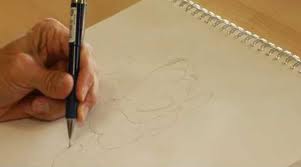
 How often have you questioned an artistic friend as to how they are able to draw so well or how they are so creative? If you have tried to draw in the past and have compared it with your creative friend, you must have asked yourself the same question that most budding artists tend to ask, “Why can’t I draw so well?” or “I wish I could draw as well as you!” on several occasions. The answer to both these questions is simple “Draw”. Well if you have thought of these things then you will definitely be motivated to learn a few tips that can help you to improve your drawing skills.
How often have you questioned an artistic friend as to how they are able to draw so well or how they are so creative? If you have tried to draw in the past and have compared it with your creative friend, you must have asked yourself the same question that most budding artists tend to ask, “Why can’t I draw so well?” or “I wish I could draw as well as you!” on several occasions. The answer to both these questions is simple “Draw”. Well if you have thought of these things then you will definitely be motivated to learn a few tips that can help you to improve your drawing skills.
Are you aware that many professionals like architects, designers and photographers don’t consider drawing to be an important aspect for their success? This is because they fail to realize the impact this knowledge will have in enhancing their work quality namely designing skills and in developing a photographic eye.
When people draw it slows them down because it is not merely capturing the image and moving onto the next image. The task expects individuals to take time to observe the object for the purpose of analyzing it and then reproducing it. It enables individuals to become very aware of its form, proportion and colour. Apart from this individuals are able to understand light and shadow and how they reveal and define form. This therefore transforms into the image that you wish to capture by giving it a realistic appearance.
Here are a few tips that help you to improve your drawings:
Tip 1 Start Drawing Something:
You need to start drawing something first. Once you have started drawing you need to draw on a regular basis. This requires you to keep drawing and practicing as much as you can because practice makes one perfect. This will also help you to become confident.
Tip 2 Look at a variety of drawings:
You can look at different types of drawings such as line drawings or drawings with meticulous details present. Looking at different creations will teach you a lot about how the artist has worked. It will give you an insight into the use of shapes and lines used. It will also teach you how shading is done.
Tip 3 Pick drawings to copy:
Try to copy drawings from famous artists such as Da Vinci and Michaelangelo sketches. This will teach you more about the techniques used by these artists.
Tip 4 Try drawing from photographs:
Many people find is easier to draw from two dimensional figures. Rather than drawing actual objects, persons and environment. When working with figures pay attention to edges, shapes and angles, don’t trace but draw instead.
Tip 5 Pick realistic drawings:
Try your hand at live figures in your environment such as pets, friends, family members, your furniture and your living spaces, vases, flowers or your favorite coffee mug. You can also try looking for objects having different reflective qualities such as teapot, ball, satin or flower and then try to draw these objects. You can also try moving the objects around and draw them from different angles or poses namely a dog running or barking etc. If you are looking for challenging objects then try drawing your hands and your feet. These are most complex parts of anatomy that are readily available. If you are able to master these, you can pretty much draw anything.
Tip 6 Go for classes:
Taking a class will not only discipline you but it will ensure that you get regular practice. Apart from this a teacher will be able to correct you whenever you go wrong and watching your classmates draw will also teach you a great deal. Watching others enhances your observational skills.
Tip 7 Maintain a sketchbook:
This will remind you to draw to fill it up, thus ensuring that you practice regularly. If possible keep it with you wherever you go so that you can fill it up as and when you wish to.
Tip 8 Be Committed:
If you have decided to do it you need to ensure that you practice regularly. For this you need to devote a certain amount of time separately per day or in a week for drawing.
Tip 9 Avoid blanking out:
At times you may find yourself blanking out to prevent this merely picking a word such as fruits, animals, people, flowers, coral reefs, waterfalls, birds or fishes can assist you in getting started.
Tip 10 Identify why you want to or need to draw:
If you understand why you want to draw it tends to motivate you to achieve what you desire thus ensuring that you improve it. In this process you tend to enjoy what you are doing as well.
Sometimes the best way to master what you want is not by thinking but rather by doing. Therefore, what are you waiting for; you may as well pick up a pencil and draw.
